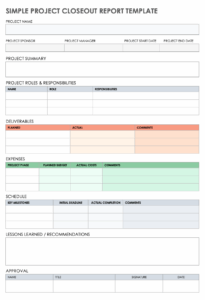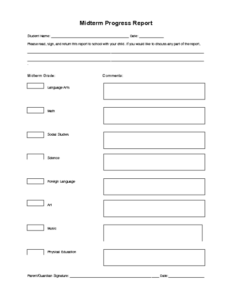Finishing a project often feels like crossing a finish line, a moment of relief and accomplishment. But what if the finish line isn’t the end, but rather a crucial checkpoint for future success? Many organizations invest significant time and resources into new systems, processes, or products, only to move on to the next big thing without a thorough look back. This can be a missed opportunity to truly understand what worked, what didn’t, and why.
That’s where the idea of a structured post implementation review comes into play. It’s about taking a deliberate pause to evaluate the project’s outcomes against its initial objectives. And to do this effectively, a well-designed post implementation review report template becomes an invaluable tool. It ensures consistency, covers all the critical areas, and helps transform anecdotal observations into actionable insights.

By systematically examining the journey and the destination, teams can pinpoint successes worth replicating and identify challenges that need addressing in future endeavors. This proactive reflection not only refines processes but also fosters a culture of continuous learning and improvement within the organization, paving the way for even more successful projects down the line.
What Makes an Effective Post Implementation Review?
An effective post implementation review (PIR) isn’t just a tick-box exercise; it’s a deep dive into the realities of a project once it has gone live. It moves beyond the immediate project delivery to assess the true impact and performance of the implemented solution in its operational environment. The goal is to gather objective evidence and subjective feedback to determine if the project has achieved its intended benefits and what lessons can be extracted for organizational growth.
This comprehensive evaluation typically scrutinizes several key areas. Did the project meet its original business objectives? Were stakeholders satisfied with the outcome and the process? How did the actual costs and timelines compare to the initial estimates? Beyond mere completion, the PIR looks at the quality of the deliverables, the efficiency of the new processes, and any unforeseen consequences, positive or negative. It’s about understanding the full picture, not just the snapshot at launch.
Key Sections of a Comprehensive PIR Report
A robust post implementation review report template should guide you through a structured examination, ensuring no critical aspect is overlooked. Think of it as a roadmap for your review process, leading to a thorough and insightful document.
Some essential components often include:
- Executive Summary: A concise overview of the project, key findings, and main recommendations.
- Project Background: Briefly describe the project, its initial goals, and the problems it aimed to solve.
- Objectives Review: Evaluate whether the project’s original objectives were met, using quantifiable metrics where possible.
- Scope and Deliverables Assessment: Confirm if all planned deliverables were completed and if the final scope aligned with expectations.
- Budget and Resource Analysis: Compare actual expenditure and resource utilization against the planned budget and allocation.
- Timeline and Schedule Performance: Assess if the project was delivered on time, identifying any deviations and their causes.
- Stakeholder Satisfaction: Incorporate feedback from end-users, project sponsors, and other key stakeholders regarding their experience and the solution’s utility.
- Identified Successes: Highlight what went well, including best practices, effective strategies, and successful outcomes.
- Identified Challenges and Lessons Learned: Document obstacles encountered, what contributed to them, and how similar issues can be avoided in the future.
- Recommendations and Action Plan: Propose concrete, actionable steps based on the findings, assigning responsibilities and deadlines.
- Appendices: Include supporting documentation such as original project plans, user feedback, or performance data.
The “Lessons Learned” and “Recommendations” sections are arguably the most critical. This is where reflection translates into future action. It’s not enough to simply list problems; the review needs to delve into the root causes and suggest practical, implementable solutions or improvements for subsequent projects. This forward-looking perspective transforms a historical document into a strategic tool.
To populate these sections effectively, a PIR relies heavily on objective data alongside qualitative feedback. This means reviewing performance metrics, budget reports, and project schedules, but also conducting interviews with various stakeholders. Gathering diverse perspectives helps create a balanced and holistic understanding of the project’s performance and impact.
Implementing Your PIR Report Template Effectively
Simply having a great post implementation review report template on hand isn’t enough; the real value comes from how you use it. The process of conducting the review itself needs to be well-planned and executed to ensure the findings are accurate, fair, and ultimately useful. It’s about establishing a routine and a mindset that values critical self-assessment as much as project completion.
Timing is a critical element in the PIR process. The review shouldn’t happen immediately after launch, as the new system or process needs time to settle in and for users to adapt. However, waiting too long can mean details are forgotten, and key personnel might have moved on. A good rule of thumb is to conduct the PIR a few weeks to a few months post-implementation, once initial teething troubles are resolved and the true impact can be observed.
To get the most out of your template, consider these practical steps:
- Assemble a diverse review team, ideally including members not directly involved in the project’s day-to-day execution to ensure objectivity.
- Gather all relevant project documentation, including initial proposals, project plans, budgets, change requests, and user acceptance testing results.
- Conduct structured interviews with all key stakeholders, from project sponsors and managers to end-users and support staff.
- Analyze all collected data, comparing actual outcomes against planned objectives and identifying variances.
- Draft the report using your chosen template, ensuring all sections are thoroughly completed and supported by evidence.
- Share the findings with relevant stakeholders, facilitate a discussion around the recommendations, and gain agreement on the action plan.
Ultimately, a post implementation review is only as valuable as the actions it inspires. The insights gleaned and the recommendations proposed must be formally documented, assigned to responsible parties, and regularly tracked for completion. This closes the loop, transforming lessons learned into tangible improvements that enhance organizational capabilities and contribute to a more efficient and successful future.
Adopting a structured approach to looking back at project outcomes helps organizations move beyond simply finishing projects to truly learning from them. It fosters a culture where continuous improvement isn’t just a buzzword, but a built-in process that elevates future initiatives.
By consistently utilizing a well-crafted post implementation review report template, teams can systematically capture knowledge, celebrate successes, and address areas for growth, ensuring that every project contributes to the organization’s overarching strategic goals.



